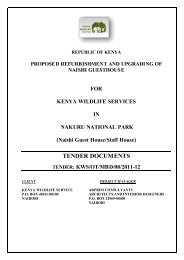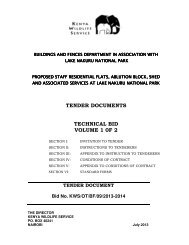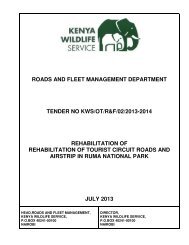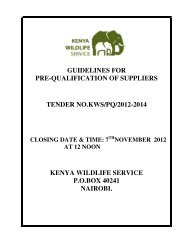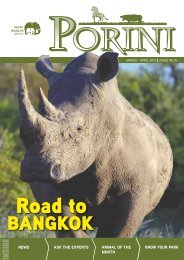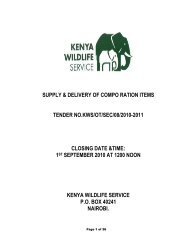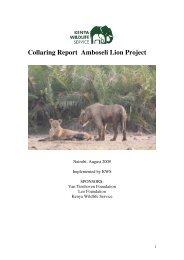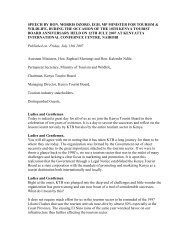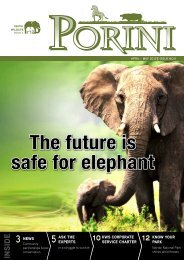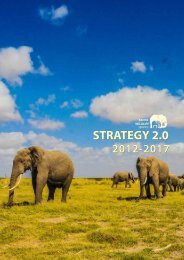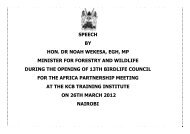Conservation and Management Strategy for the Elephant in Kenya
Conservation and Management Strategy for the Elephant in Kenya
Conservation and Management Strategy for the Elephant in Kenya
Create successful ePaper yourself
Turn your PDF publications into a flip-book with our unique Google optimized e-Paper software.
CONSERVATION AND MANAGEMENT STRATEGY FOR THE ELEPHANT IN KENYA 1<br />
1. Introduction<br />
<strong>Elephant</strong>s present tremendous challenges <strong>for</strong> <strong>the</strong>ir successful conservation management, challenges that are <strong>in</strong><br />
certa<strong>in</strong> aspects unique <strong>and</strong> <strong>in</strong> o<strong>the</strong>rs, typical of wildlife conservation <strong>in</strong> general. First <strong>and</strong> <strong>for</strong>emost, it is important to<br />
keep <strong>in</strong> m<strong>in</strong>d that elephants, like all o<strong>the</strong>r wildlife, do not exist separately from <strong>the</strong> ecosystems <strong>the</strong>y <strong>in</strong>habit.<br />
Successful conservation of elephants should focus not simply on <strong>the</strong> animals alone, but should fit with<strong>in</strong> <strong>the</strong> larger<br />
biodiversity goals of <strong>Kenya</strong>. This will <strong>in</strong>clude people, habitats, l<strong>and</strong>scapes <strong>and</strong> <strong>the</strong> role elephants play <strong>in</strong> <strong>the</strong>se areas.<br />
The strategy is based on broad pr<strong>in</strong>ciples <strong>and</strong> focuses on collaboration <strong>and</strong>, where possible,<br />
decentralisation <strong>and</strong> devolution.<br />
At <strong>the</strong> centre of <strong>the</strong> challenge is <strong>the</strong> biology of elephants. Any management solutions must recognise <strong>and</strong><br />
accommodate <strong>the</strong> key aspects of elephant biology, <strong>in</strong>clud<strong>in</strong>g <strong>the</strong>ir:<br />
• Large size <strong>and</strong> consequent life-history parameters – long potential lifespan, long calf dependence, slow<br />
demographic variables result<strong>in</strong>g <strong>in</strong> low population growth rates.<br />
• Generalist feed<strong>in</strong>g behaviour, which requires large quantities of vegetation from all layers, rang<strong>in</strong>g <strong>in</strong> quality<br />
from nutritious fruits to coarse grasses <strong>and</strong> woody stems, from agricultural crops to shrubs <strong>and</strong> trees.<br />
• High mobility, allow<strong>in</strong>g – <strong>in</strong>deed requir<strong>in</strong>g – large home ranges.<br />
• Exceptional <strong>in</strong>telligence, communication <strong>and</strong> memory, lead<strong>in</strong>g to flexible <strong>and</strong> variable responses to chang<strong>in</strong>g<br />
habitat conditions <strong>and</strong> disturbance, as well as recollection of habitat resources <strong>and</strong> of conflict with people.<br />
• High sociality, with matril<strong>in</strong>eal family groups as <strong>the</strong> context <strong>for</strong> social learn<strong>in</strong>g. This social bond<strong>in</strong>g <strong>and</strong> capacity<br />
<strong>for</strong> learn<strong>in</strong>g <strong>in</strong>creases behavioural flexibility, with <strong>the</strong> pass<strong>in</strong>g-on of acquired knowledge, <strong>and</strong> is also a potential<br />
vulnerability, <strong>in</strong> that if disrupted by <strong>the</strong> loss of key <strong>in</strong>dividuals it can result <strong>in</strong> aberrant behaviour.<br />
A fur<strong>the</strong>r <strong>and</strong> equally important aspect of <strong>the</strong> challenge of elephant management is <strong>the</strong> various, <strong>and</strong> often strongly<br />
held, values that people attribute to <strong>the</strong>m. <strong>Elephant</strong>s are:<br />
• A ‘flagship’ species, a charismatic terrestrial mammal, which can be used to generate <strong>in</strong>terest <strong>in</strong>, <strong>and</strong> f<strong>in</strong>ancial<br />
support <strong>for</strong>, <strong>the</strong> conservation of all wildlife which share <strong>the</strong>ir habitats.<br />
• An ‘umbrella’ species, whose protection provides collateral security <strong>for</strong> overall biodiversity <strong>and</strong> <strong>for</strong> <strong>the</strong> tourist<br />
<strong>in</strong>dustry.<br />
• A ‘conflict’ species, an economic burden similar to o<strong>the</strong>r wild animals that affect <strong>the</strong> livelihood <strong>in</strong>terests of<br />
people, through <strong>the</strong>ir contribution to crop failure, livestock mortality, property damage <strong>and</strong> <strong>in</strong>jury or loss of life,<br />
normally driven by lack of l<strong>and</strong>-use <strong>and</strong> zonation plans. There are many factors, <strong>in</strong>clud<strong>in</strong>g climate <strong>and</strong> human<br />
actions, that contribute to agricultural <strong>and</strong> property losses, which <strong>in</strong> numerical terms may have greater impact<br />
than elephants, but <strong>in</strong> <strong>the</strong> case of elephants, <strong>the</strong> effects are dramatic <strong>and</strong>, at <strong>the</strong> time of <strong>the</strong> event, can be<br />
catastrophic.<br />
• An ‘architect’ species, capable of modify<strong>in</strong>g habitats to <strong>the</strong> benefit or detriment of different plant <strong>and</strong> animal<br />
species on a local or wider scale, depend<strong>in</strong>g on <strong>the</strong> nature <strong>and</strong> extent of <strong>the</strong> impact. In cases where <strong>the</strong><br />
presence of elephants has a strong <strong>in</strong>fluence on o<strong>the</strong>r species, <strong>the</strong>y may be considered a ‘keystone’ species,<br />
whose removal is likely to have a correspond<strong>in</strong>gly strong, even ‘cascad<strong>in</strong>g’ effect on <strong>the</strong> structure <strong>and</strong> function<br />
of ecosystems.<br />
All <strong>the</strong>se aspects have bear<strong>in</strong>g on <strong>the</strong> approaches that should be taken <strong>in</strong> elephant conservation <strong>and</strong> management.<br />
They create difficulties, but also opportunities. These various aspects <strong>for</strong>m <strong>the</strong> <strong>the</strong>me of <strong>the</strong> National <strong>Elephant</strong><br />
<strong>Conservation</strong> <strong>and</strong> <strong>Management</strong> <strong>Strategy</strong> <strong>for</strong> <strong>Kenya</strong>.<br />
[ TOP LEFT ] Plate 18.<br />
The Ewaso Ng’iro river is a vital resource <strong>for</strong> elephants <strong>in</strong> Nor<strong>the</strong>rn <strong>Kenya</strong> - Lucy K<strong>in</strong>g, Save <strong>the</strong> <strong>Elephant</strong>s



